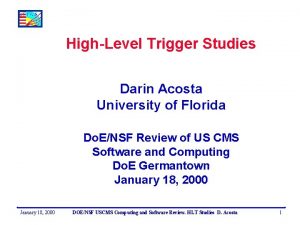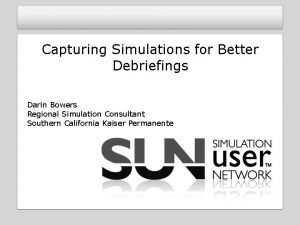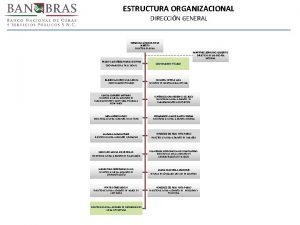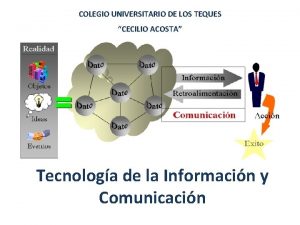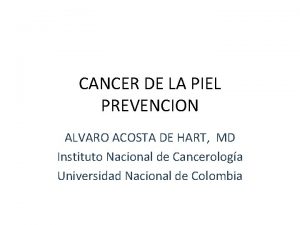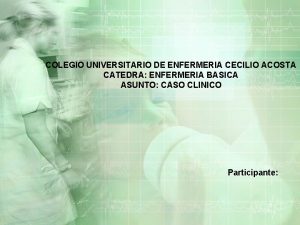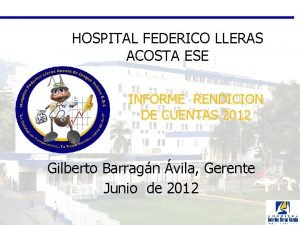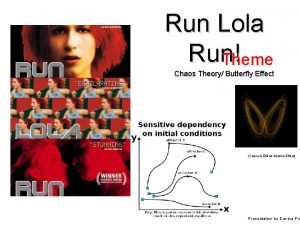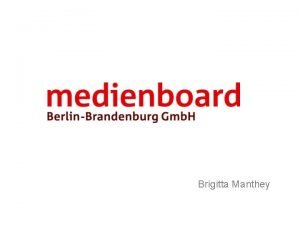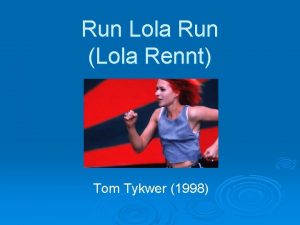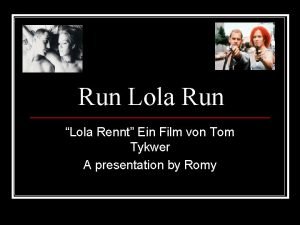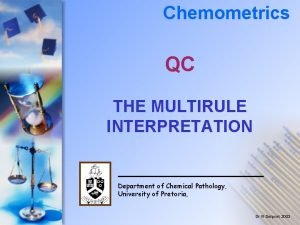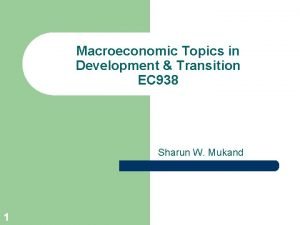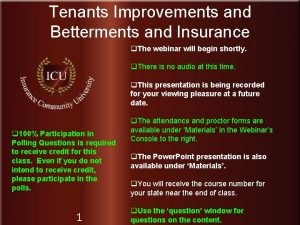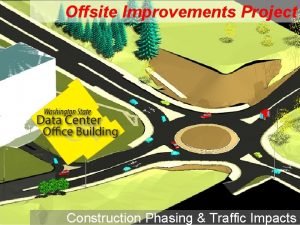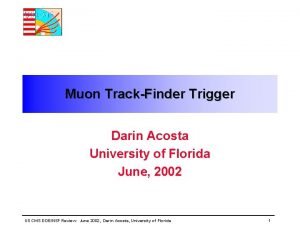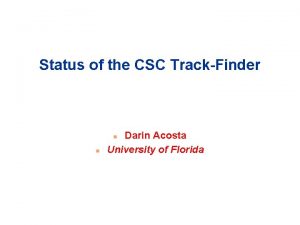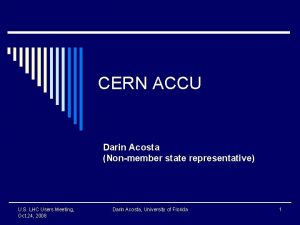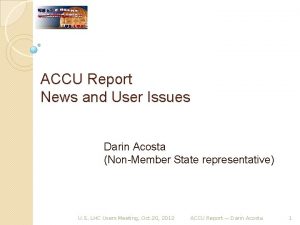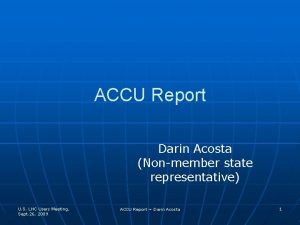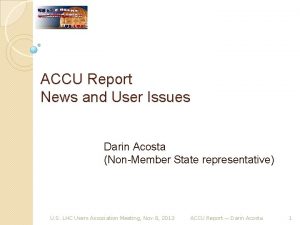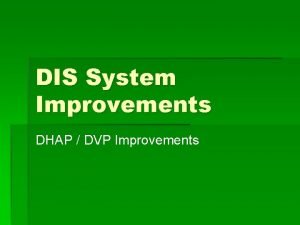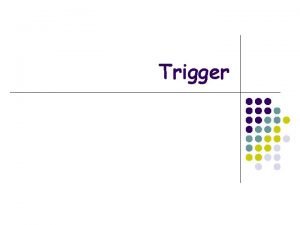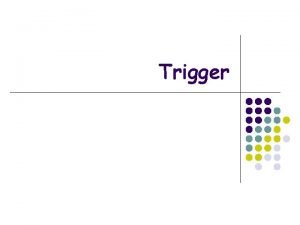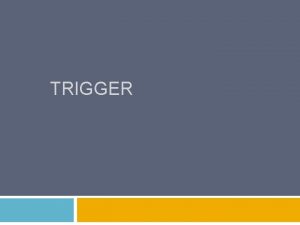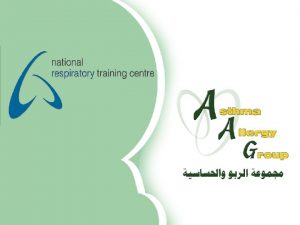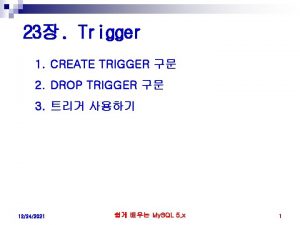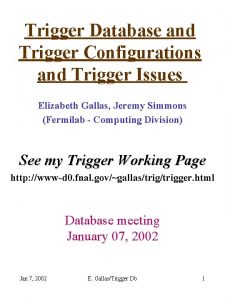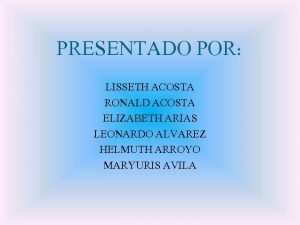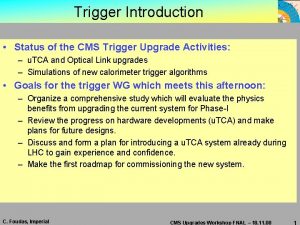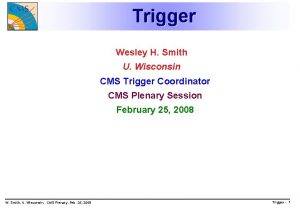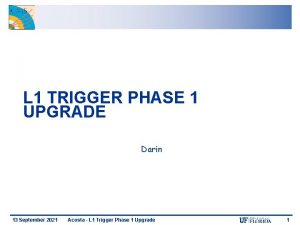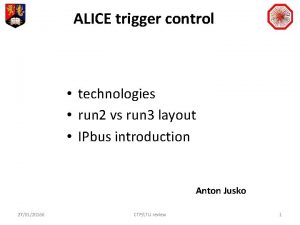CMS TRIGGER IMPROVEMENTS TOWARDS RUN II Darin Acosta




























- Slides: 28

CMS TRIGGER IMPROVEMENTS TOWARDS RUN II Darin Acosta University of Florida 5 July 2014 CMS Trigger Improvements -- D. Acosta 1

CMS Trigger Architecture Two levels: Ø Level-1: custom electronics to reduce event rate from 20 -40 MHz to no more than 100 k. Hz for the detector readout electronics, with 4 μs latency Ø High Level Trigger (HLT): event filter farm comprised of commercial CPUs running software to further reduce event rate to storage to an average of ~1 k. Hz for Run 2 40 MHz, 1 k. Hz 5 July 2014 CMS Trigger Improvements -- D. Acosta 2

Run 2 Trigger Improvements Trigger rates for Run 2 of the LHC are driven by the increase in luminosity, the center-of-mass energy, and by higher pileup Ø Lumi and √s lead to a factor ~4 increase Nevertheless the physics program compels us to maintain sensitivity for electroweak scale physics and for Te. V scale searches similar to that of LHC Run 1 Mitigate L 1 Trigger rates with an upgrade to improve: e/γ and τ cluster footprints and isolation Ø muon p. T resolution and muon isolation Ø jets with PU subtraction Ø L 1 menu sophistication (#lines, complexity) Ø Improve HLT rates and CPU time by improving Tracking performance Ø Object reconstruction Ø Isolation Ø 5 July 2014 CMS Trigger Improvements -- D. Acosta 3

L 1 Trigger Upgrade Detailed design and motivation documented in a Technical Design Report CERN-LHCC-2013 -011, CMS-TDR-012 (2013) Ø https: //cds. cern. ch/record/1556311 Ø Essentially a complete replacement of the existing system Increase system flexibility with high bandwidth optical links and large FPGAs Ø Further standardization across systems using μTCA telecomm platform Ø Build and commission upgrade in parallel with current trigger Ø Target deployment in 2016 Preparations already during current LHC LS 1 (i. e. signal splitting) Ø Limited deployment of calo trigger improvements in 2015 Ø 5 July 2014 CMS Trigger Improvements -- D. Acosta 4

Overall L 1 Trigger Upgrade Scheme Two-layer calorimeter trigger with calorimeter tower-level precision and pile-up subtraction Integrated muon trigger combining all 3 muon systems in track-finding with a more sophisticated p. T measurement 5 July 2014 CMS Trigger Improvements -- D. Acosta 5

Calorimeter L 1 Trigger Transition Upgrade commissioning designed to take place in parallel Duplicate ECAL signals with active optical components Ø Split HCAL optical inputs to HCAL back-end electronics l Both during the current Long Shutdown 1 (LS 1) Ø 5 July 2014 CMS Trigger Improvements -- D. Acosta 6

Calorimeter L 1 Trigger Transition Replacement of copper cable connections with optical connections from ECAL trigger primitive boards to both existing and upgraded calorimeter trigger systems Production is done Ø Installation of fibers and mezzanine cards is complete Ø Commissioning is underway Ø 5 July 2014 CMS Trigger Improvements -- D. Acosta 7

L 1 Calo Trigger Upgrade Architecture: “Time Multiplexing” Event serving to Layer-2 processors for jet-finding, etc. like High Level Trigger 5 July 2014 CMS Trigger Improvements -- D. Acosta 8

Calo Trigger Upgrade Hardware Status Calo Layer 1 (“CTP 7” card) Ø Ø Ø Receive data from calorimeters, precluster and format for global processing 2 prototypes built and tested Excellent results with processor system, power supplies, clock system and optical/backplane links (Tested 4. 8 – 10 Gbps) Tested successfully with ECAL and HCAL inputs Production to start in October Calo layer 2 (“MP 7” card) Global processing layer (jets, E sums, isolation, …) Ø 72 Rx and 72 Tx @ 10 Gbps fully tested Ø Delivery and testing of initial production cards has started Ø Optical patch panels Ø Specifications complete and orders out 5 July 2014 CMS Trigger Improvements -- D. Acosta 9

Partial Calo Trigger Upgrade in 2015 The copper outputs of the legacy Regional Calorimeter Trigger are converted to 10 Gbps optical signals which can drive a couple new Layer-2 MP 7 processors Algorithms running on two MP 7 Cards provide better electron isolation, better tau trigger, and jet PU subtraction early in 2015 New optical interfaces successfully tested Ø Production launched Ø Firmware development is in progress Ø New 5 July 2014 CMS Trigger Improvements -- D. Acosta 10

CMS Muon System and Trigger Barrel: Drift-Tubes (DT) and Resistive Plate Chambers (RPC) Overlap: DT, RPC, CSC Endcap: Cathode Strip Chambers (CSC) and RPC All selftriggering 5 July 2014 11 Trigger Improvements -- D. Acosta CMS

Muon Detector Improvements during LS 1 Add fourth layer of CSC and RPC coverage in endcaps for robustness and higher efficiency, along with new outermost shielding wall Improve the triggering and readout for 2. 1<|η|<2. 4 for the first CSC layer in endcaps (new front-end and trigger electronics) See also L. Guiducci’s talk, Friday 15: 00 5 July 2014 CMS Trigger Improvements -- D. Acosta 12

Muon Trigger Upgrade Transition Install parallel and higher bandwidth optical paths New system Legacy system Full split of endcap CSC signals with modified Muon Port Cards installed in cavern during LS 1 (and sends all CSC segments) Ø DT trigger electronics moved from cavern to counting room Ø Split RPC signals and a slice of the DT to commission the new trigger Ø Build up new Muon Track Finders in 2015 and commission in parallel Ready for physics by 2016 5 July 2014 CMS Trigger Improvements -- D. Acosta 13

Muon Track Finder Upgrade Improve upon successful features of current muon trigger Enlarge LUT memory for p. T assignment from MBs to GBs, allowing use of more angles in “fit” Ø Larger FPGA to handle more hits from pile-up, additional chambers Ø Use the redundancy of the three muon detection systems earlier in trigger chain Ø Create a higher resolution and more robust muon trigger rather than combine lower resolution ones Add calorimeter isolation Report more muons and increase precision Ø Improved isolation, b-tagging, invariant mass, etc. at the Global Trigger 5 July 2014 14 CMS Trigger Improvements -- D. Acosta

Muon Trigger Upgrade Status Muon trigger link concentration and fan-out First assembled prototypes just received for DT/RPC barrel optical links Ø CSC MPC mezzanines ready for installation and commissioning Ø “MTF 7” Processor Status Ø Ø Ø Intended for muon endcap and barrel/endcap overlap Dual-card design with 1 GB memory Extensively tested at 3. 2 Gbps and 10 Gbps asynch. 3 prototypes built, one at CERN ready for integration tests Production to start in October 5 July 2014 CMS Trigger Improvements -- D. Acosta 15

Global Muon Trigger & Global Trigger Hardware platform is the MP 7 (Calo) processor for both μGMT algorithm logic has been developed: New: Sorting all 108 muons from Track-Finders to final 8 muons, absorbing a separate muon sorting layer to save latency Ø New: Calorimeter-based isolation (incl. extrapolation + pile-up subtraction) Ø Baseline firmware implemented, algorithm development on track Ø μGT New: remove limitation on # triggers (>128), and offer more complex relations between objects (e. g. invariant mass) Ø Object interfaces and data formats defined Ø First version of μGT menu is available Ø Firmware development and testing underway Ø 5 July 2014 CMS Trigger Improvements -- D. Acosta 16

Performance: Trigger Thresholds CERN-LHCC-2013 -011 e: 50 Ge. V 30 Ge. V μ: 40 Ge. V 20 Ge. V 5 July 2014 CMS Trigger Improvements -- D. Acosta 17

L 1 Upgrade Tau Trigger Performance Hadronic tau trigger with tower level granularity Ø Efficiency significantly improved over Run 1 μ+τ trigger: 30% rate reduction and higher efficiency 5 July 2014 CMS Trigger Improvements -- D. Acosta 18

HIGH LEVEL TRIGGER 5 July 2014 CMS Trigger Improvements -- D. Acosta 19

Tracking Improvements HLT uses regional tracking of strip and pixel hits in an iterative approach for different track categories In order to mitigate effects from pile-up, the CPU processing time has been reduced: Optimization of code Ø Primary vertex constraint in all iterations Ø Optimization of region p. T cuts Ø Removal of last two tracking iterations (of 5) except for displaced track triggers Ø Overall a factor ~4 reduction in CPU time 5 July 2014 CMS Trigger Improvements -- D. Acosta 20

Vertexing Improvements have been made to the fast pixel primary vertex finding algorithm, which works from pixel clusters before the iterative track reconstruction is performed The HLT b-tagging discriminant for jets has improved with the improvements to the iterative tracking 15% reduction in CPU time, tt sample 5 July 2014 CMS Trigger Improvements -- D. Acosta 21

Electron Clustering and Isolation New electron superclustering algorithm from Particle Flow objects built from tracks, ECAL and HCAL clusters New isolation built from Particle Flow objects, including pile-up subtraction Ø Similar performance as with offline isolation 30% better background rejection Improved pile-up dependence of efficiency 5 July 2014 CMS Trigger Improvements -- D. Acosta 22

Muon Tracking and Isolation Improvements to the muon track reconstruction algorithm to improve the pile-up dependence of the efficiency plus additional quality cuts Ø Rate increment is only 4. 3% for isolated muons with P T ≥ 24 Ge. V Impact of a very loose track-based isolation cut applied to both legs of double muon triggers has been assessed Ø 56% rate reduction for <1% inefficiency 5 July 2014 CMS Trigger Improvements -- D. Acosta 23

Run 2 Trigger Summary The L 1 Trigger upgrade project is well underway A considerable part of the hardware is in production Ø The rest of the hardware has been successfully prototyped and should be read to commence production within 2014 Ø Performance significantly improved for Run 2 Ø The High Level Trigger algorithms significantly improved for Run 2 Iterative tracking CPU timing dramatically reduced without compromising performance, benefiting many triggers using tracking Ø Lepton isolation is improved, with better pile-up dependence Ø Trigger menus for 2015 LHC operations at 13 Te. V are in progress 5 July 2014 CMS Trigger Improvements -- D. Acosta 24

BACK-UP 5 July 2014 CMS Trigger Improvements -- D. Acosta 25

1. 1 x 1034 cm– 2 s– 1 2. 2 x 1034 cm– 2 s– 1 Current Upgrade W(ev), H(bb) 57. 7% 87. 0% 37. 5% 71. 5% W(μv), H(bb) 95. 9% 100% 69. 6% 97. 9% VBF H(ττ(μt)) 42. 6% 51. 3% 19. 4% 48. 4% VBF H(ττ(et)) 24. 4% 44. 3% 14. 0% 39. 0% VBF H(ττ(τhτh)) 17. 2% 53. 7% 14. 9% 50. 1% H(WW(eevv)) 91. 4% 97. 8% 74. 2% 95. 3% H(WW(μμvv)) 99. 9% 89. 3% 99. 9% H(WW(eμvv)) 97. 6% 99. 4% 86. 9% 99. 3% H(WW(μevv)) 99. 6% 99. 5% 90. 7% 99. 7% Stop b. Wc e, jets (600 – 450 Ge. V) 55. 8% 68. 2% 50. 3% 64. 8% Stop b. Wc μ, jets (600 – 450 Ge. V) 78. 1% 81. 6% 76. 4% 84. 5% RPV Stop jets (200 Ge. V) 70. 1% 99. 9% 43. 6% 99. 9% RPV Stop jets (300 Ge. V) 93. 7% 99. 9% 79. 7% 99. 9% Process (x 2 improvement highlighted) 5 July 2014 CMS Trigger Improvements -- D. Acosta Average Improvement: 17% (Low Lumi) & 40% (High Lumi) Physics Performance Summary for Upgrade 26

Tests of L 1 Calo Trigger Upgrade Time-multiplexing Setup: l Two layer 1 pre-processors, one layer 2 main processing node, and a de-multiplexing card Ø Objectives: l Reliable transmission of data at 10 Gb/s l Successful alignment of all links l Implementation of an algorithm and successful transmission of data through it l Verification of latency Ø Results: l All objectives successfully met Ø 5 July 2014 CMS Trigger Improvements -- D. Acosta 27

L 1 Muon Track-Finder Integration tests Mimicking real system setup: Sending data from 2 MPCs to MTF 6 Ø Each MPC clocked by separate CCB Ø MTF 6 receives clock from AMC 13 Ø CCBs and AMC 13 receive clock from common source Ø Types of tests: l PRBS, and random data via test FIFOs Ø Result: l No errors. Ø Also tested successfully the PT LUT, and PCI express interface 5 July 2014 CMS Trigger Improvements -- D. Acosta
 Darin acosta
Darin acosta Novosirisk
Novosirisk Darin bowers
Darin bowers Paula molina acosta
Paula molina acosta Carlos mier y teran ordiales
Carlos mier y teran ordiales Marisol acosta
Marisol acosta Colegio universitario cecilio acosta
Colegio universitario cecilio acosta Baston de galton
Baston de galton Alvaro acosta de hart
Alvaro acosta de hart Universidad cecilio acosta enfermería
Universidad cecilio acosta enfermería Hospital federico lleras acosta ese - sede limonar
Hospital federico lleras acosta ese - sede limonar Long run supply curve
Long run supply curve Perfect competition long run equilibrium
Perfect competition long run equilibrium Themes in run lola run
Themes in run lola run Run lola run script
Run lola run script Run lola run editing techniques
Run lola run editing techniques Das brandneue testament imdb
Das brandneue testament imdb Within run and across run meaning
Within run and across run meaning Short run vs long run economics
Short run vs long run economics Tenant improvement and betterments
Tenant improvement and betterments Improvements roadmap
Improvements roadmap What improvements have been made to kevlar
What improvements have been made to kevlar Direct improvements
Direct improvements Www.svcfin.com make a payment
Www.svcfin.com make a payment Medicare improvements for patients and providers act
Medicare improvements for patients and providers act Offsite improvements
Offsite improvements Decision trigger
Decision trigger Walter cannon observed that a variety of stressors trigger
Walter cannon observed that a variety of stressors trigger Asynchronous trigger sql server
Asynchronous trigger sql server
